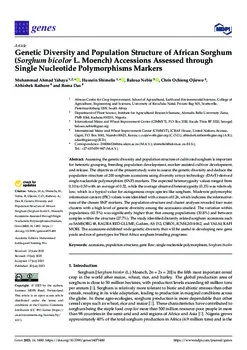Genetic diversity and population structure of African sorghum (sorghum bicolor L. moench) accessions assessed through single nucleotide polymorphisms markers

Abstract
Assessing the genetic diversity and population structure of cultivated sorghum is important for heterotic grouping, breeding population development, marker-assisted cultivar development, and release. The objectives of the present study were to assess the genetic diversity and deduce the population structure of 200 sorghum accessions using diversity arrays technology (DArT)-derived single nucleotide polymorphism (SNP) markers. The expected heterozygosity values ranged from 0.10 to 0.50 with an average of 0.32, while the average observed heterozygosity (0.15) was relatively low, which is a typical value for autogamous crops species like sorghum. Moderate polymorphic information content (PIC) values were identified with a mean of 0.26, which indicates the informativeness of the chosen SNP markers. The population structure and cluster analyses revealed four main clusters with a high level of genetic diversity among the accessions studied. The variation within populations (41.5%) was significantly higher than that among populations (30.8%) and between samples within the structure (27.7%). The study identified distantly related sorghum accessions such as SAMSORG 48, KAURA RED GLUME; Gadam, AS 152; CSRO1, ICNSL2014-062; and YALAI, KAFI MORI. The accessions exhibited wide genetic diversity that will be useful in developing new gene pools and novel genotypes for West Africa sorghum breeding programs.
